Page 234 of 350
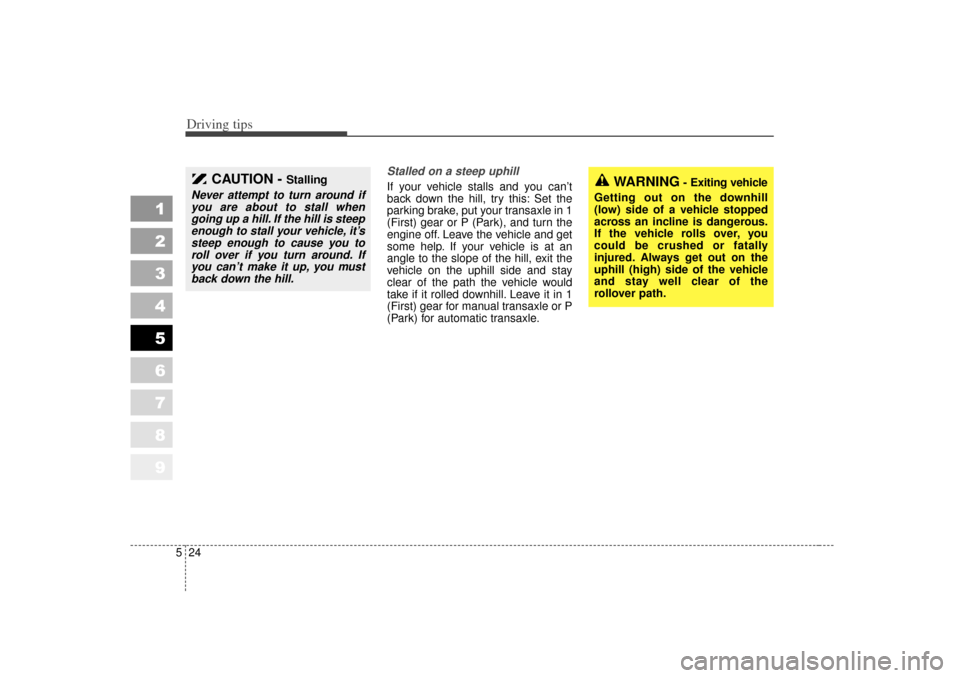
Driving tips24
5
1
2
3
4
5
6
7
8
9
Stalled on a steep uphillIf your vehicle stalls and you can’t
back down the hill, try this: Set the
parking brake, put your transaxle in 1
(First) gear or P (Park), and turn the
engine off. Leave the vehicle and get
some help. If your vehicle is at an
angle to the slope of the hill, exit the
vehicle on the uphill side and stay
clear of the path the vehicle would
take if it rolled downhill. Leave it in 1
(First) gear for manual transaxle or P
(Park) for automatic transaxle.
CAUTION -
Stalling
Never attempt to turn around if
you are about to stall whengoing up a hill. If the hill is steepenough to stall your vehicle, it’ssteep enough to cause you toroll over if you turn around. Ifyou can’t make it up, you mustback down the hill.
WARNING
- Exiting vehicle
Getting out on the downhill
(low) side of a vehicle stopped
across an incline is dangerous.
If the vehicle rolls over, you
could be crushed or fatally
injured. Always get out on the
uphill (high) side of the vehicle
and stay well clear of the
rollover path.
Page 235 of 350
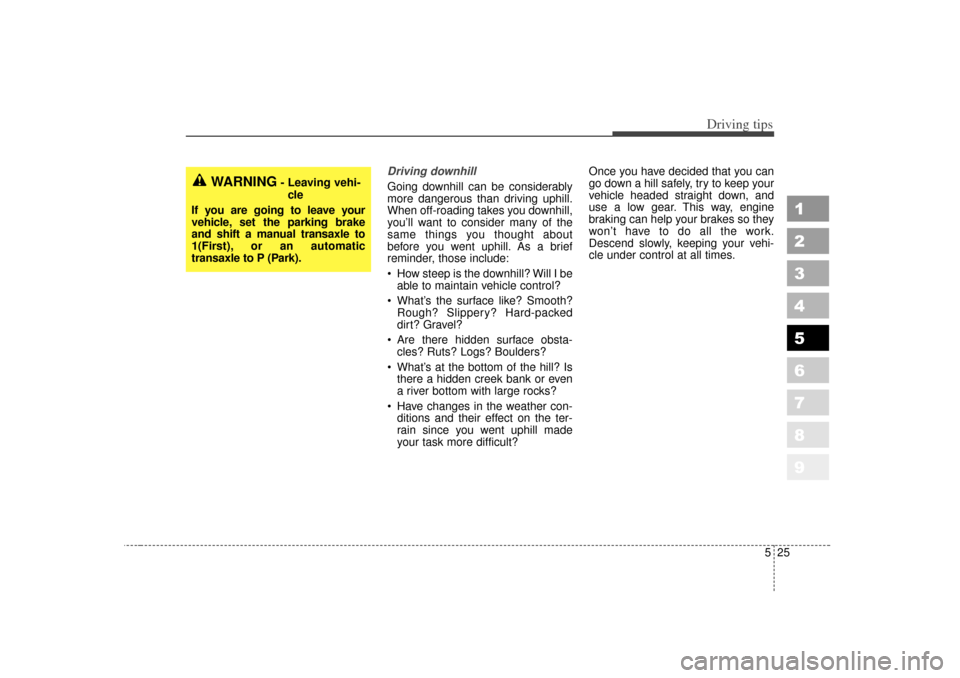
525
Driving tips
1
2
3
4
5
6
7
8
9
Driving downhillGoing downhill can be considerably
more dangerous than driving uphill.
When off-roading takes you downhill,
you’ll want to consider many of the
same things you thought about
before you went uphill. As a brief
reminder, those include:
How steep is the downhill? Will I beable to maintain vehicle control?
What’s the surface like? Smooth? Rough? Slippery? Hard-packed
dirt? Gravel?
Are there hidden surface obsta- cles? Ruts? Logs? Boulders?
What’s at the bottom of the hill? Is there a hidden creek bank or even
a river bottom with large rocks?
Have changes in the weather con- ditions and their effect on the ter-
rain since you went uphill made
your task more difficult? Once you have decided that you can
go down a hill safely, try to keep your
vehicle headed straight down, and
use a low gear. This way, engine
braking can help your brakes so they
won’t have to do all the work.
Descend slowly, keeping your vehi-
cle under control at all times.
WARNING
- Leaving vehi-
cle
If you are going to leave your
vehicle, set the parking brake
and shift a manual transaxle to
1(First), or an automatic
transaxle to P (Park).
Page 236 of 350
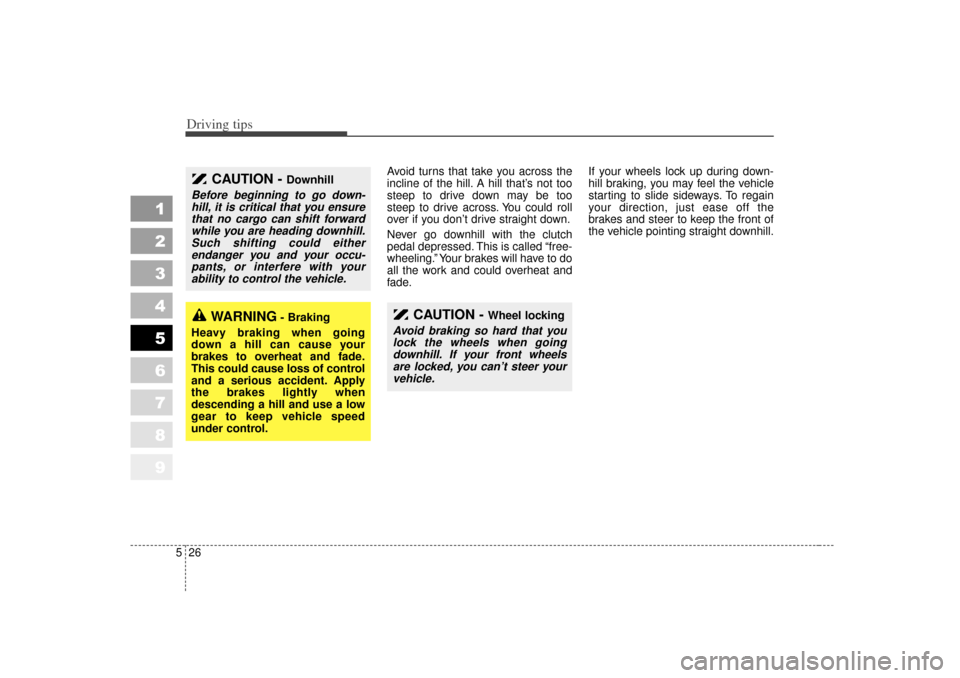
Driving tips26
5
1
2
3
4
5
6
7
8
9
Avoid turns that take you across the
incline of the hill. A hill that’s not too
steep to drive down may be too
steep to drive across. You could roll
over if you don’t drive straight down.
Never go downhill with the clutch
pedal depressed. This is called “free-
wheeling.” Your brakes will have to do
all the work and could overheat and
fade. If your wheels lock up during down-
hill braking, you may feel the vehicle
starting to slide sideways. To regain
your direction, just ease off the
brakes and steer to keep the front of
the vehicle pointing straight downhill.
CAUTION -
Downhill
Before beginning to go down-
hill, it is critical that you ensurethat no cargo can shift forwardwhile you are heading downhill.Such shifting could eitherendanger you and your occu-pants, or interfere with yourability to control the vehicle.
WARNING
- Braking
Heavy braking when going
down a hill can cause your
brakes to overheat and fade.
This could cause loss of control
and a serious accident. Apply
the brakes lightly when
descending a hill and use a low
gear to keep vehicle speed
under control.
CAUTION -
Wheel locking
Avoid braking so hard that you lock the wheels when goingdownhill. If your front wheelsare locked, you can’t steer yourvehicle.
Page 238 of 350
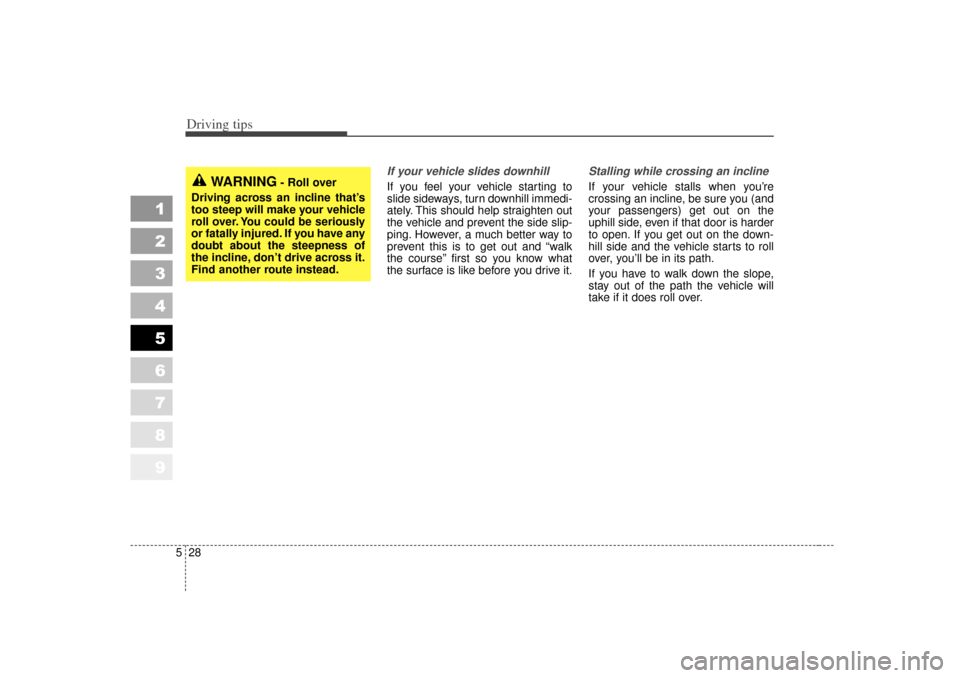
Driving tips28
5
1
2
3
4
5
6
7
8
9
If your vehicle slides downhillIf you feel your vehicle starting to
slide sideways, turn downhill immedi-
ately. This should help straighten out
the vehicle and prevent the side slip-
ping. However, a much better way to
prevent this is to get out and “walk
the course” first so you know what
the surface is like before you drive it.
Stalling while crossing an inclineIf your vehicle stalls when you’re
crossing an incline, be sure you (and
your passengers) get out on the
uphill side, even if that door is harder
to open. If you get out on the down-
hill side and the vehicle starts to roll
over, you’ll be in its path.
If you have to walk down the slope,
stay out of the path the vehicle will
take if it does roll over.
WARNING
- Roll over
Driving across an incline that’s
too steep will make your vehicle
roll over. You could be seriously
or fatally injured. If you have any
doubt about the steepness of
the incline, don’t drive across it.
Find another route instead.
Page 239 of 350
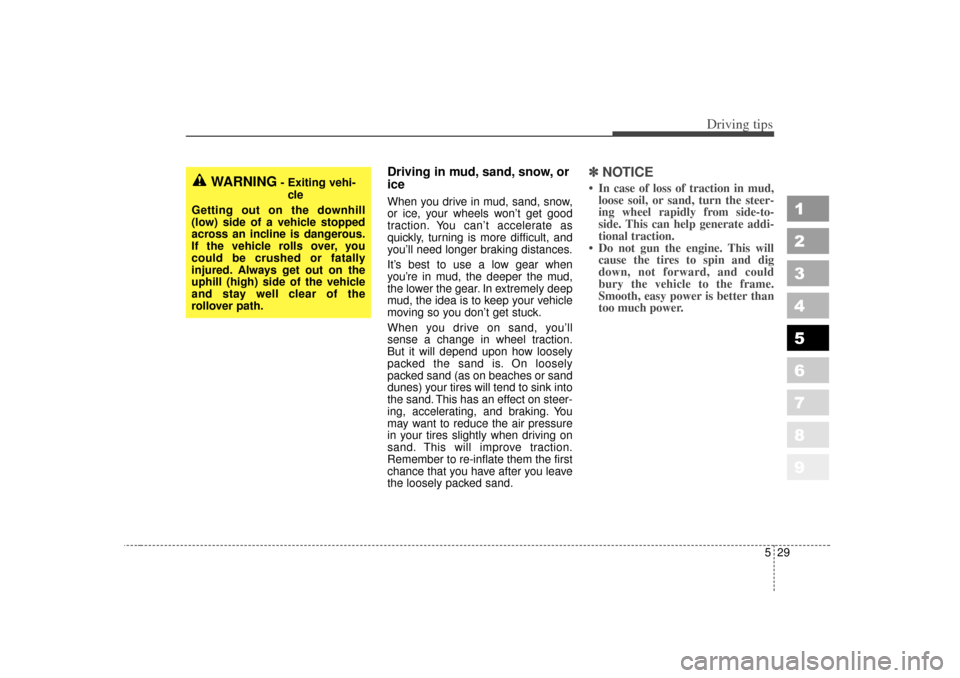
529
Driving tips
1
2
3
4
5
6
7
8
9
Driving in mud, sand, snow, or
iceWhen you drive in mud, sand, snow,
or ice, your wheels won’t get good
traction. You can’t accelerate as
quickly, turning is more difficult, and
you’ll need longer braking distances.
It’s best to use a low gear when
you’re in mud, the deeper the mud,
the lower the gear. In extremely deep
mud, the idea is to keep your vehicle
moving so you don’t get stuck.
When you drive on sand, you’ll
sense a change in wheel traction.
But it will depend upon how loosely
packed the sand is. On loosely
packed sand (as on beaches or sand
dunes) your tires will tend to sink into
the sand. This has an effect on steer-
ing, accelerating, and braking. You
may want to reduce the air pressure
in your tires slightly when driving on
sand. This will improve traction.
Remember to re-inflate them the first
chance that you have after you leave
the loosely packed sand.
✽ ✽NOTICE• In case of loss of traction in mud,
loose soil, or sand, turn the steer-
ing wheel rapidly from side-to-
side. This can help generate addi-
tional traction.
• Do not gun the engine. This will cause the tires to spin and dig
down, not forward, and could
bury the vehicle to the frame.
Smooth, easy power is better than
too much power.
WARNING
- Exiting vehi-
cle
Getting out on the downhill
(low) side of a vehicle stopped
across an incline is dangerous.
If the vehicle rolls over, you
could be crushed or fatally
injured. Always get out on the
uphill (high) side of the vehicle
and stay well clear of the
rollover path.
Page 240 of 350
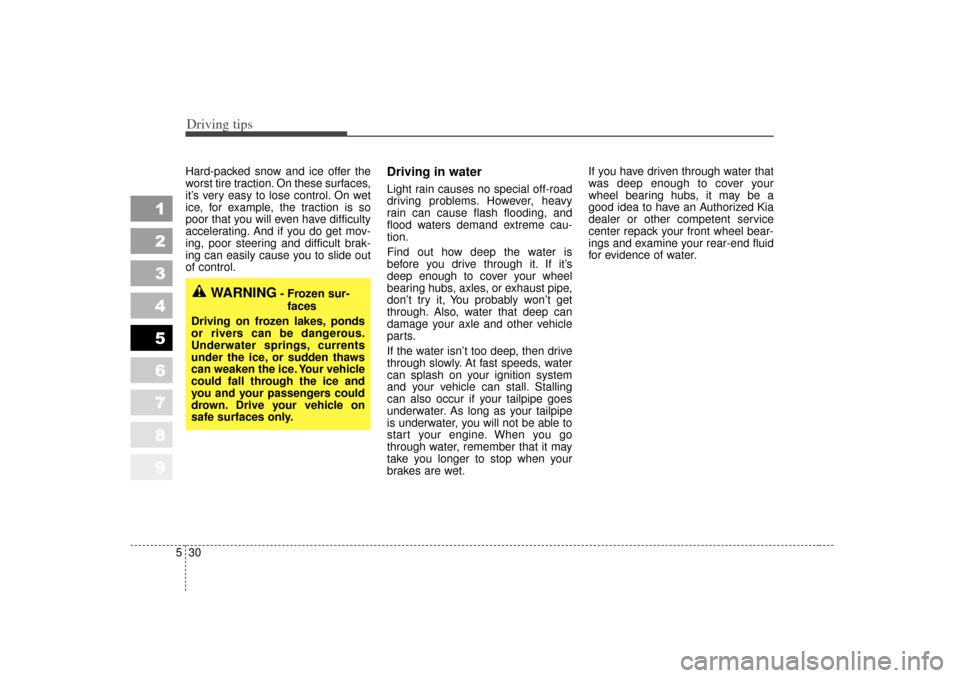
Driving tips30
5
1
2
3
4
5
6
7
8
9
Hard-packed snow and ice offer the
worst tire traction. On these surfaces,
it’s very easy to lose control. On wet
ice, for example, the traction is so
poor that you will even have difficulty
accelerating. And if you do get mov-
ing, poor steering and difficult brak-
ing can easily cause you to slide out
of control.
Driving in waterLight rain causes no special off-road
driving problems. However, heavy
rain can cause flash flooding, and
flood waters demand extreme cau-
tion.
Find out how deep the water is
before you drive through it. If it’s
deep enough to cover your wheel
bearing hubs, axles, or exhaust pipe,
don’t try it, You probably won’t get
through. Also, water that deep can
damage your axle and other vehicle
parts.
If the water isn’t too deep, then drive
through slowly. At fast speeds, water
can splash on your ignition system
and your vehicle can stall. Stalling
can also occur if your tailpipe goes
underwater. As long as your tailpipe
is underwater, you will not be able to
start your engine. When you go
through water, remember that it may
take you longer to stop when your
brakes are wet. If you have driven through water that
was deep enough to cover your
wheel bearing hubs, it may be a
good idea to have an Authorized Kia
dealer or other competent service
center repack your front wheel bear-
ings and examine your rear-end fluid
for evidence of water.
WARNING
- Frozen sur-
faces
Driving on frozen lakes, ponds
or rivers can be dangerous.
Underwater springs, currents
under the ice, or sudden thaws
can weaken the ice. Your vehicle
could fall through the ice and
you and your passengers could
drown. Drive your vehicle on
safe surfaces only.
Page 241 of 350
531
Driving tips
1
2
3
4
5
6
7
8
9
After off-road drivingRemove any brush or debris that has
collected on the underbody, chassis
or under the hood. These accumula-
tions can be a fire hazard.
After driving in mud or sand, clean
and check the brake linings.
Accumulation of mud or sand can
cause glazing and uneven braking.
Check the body structure, steering,
suspension, wheels, tires, and
exhaust system for damage. Also,
check the fuel lines and cooling sys-
tem for any leakage. Your vehicle will
also require more frequent service
due to off-road use.
WARNING
- Water
Driving through rushing water
can be dangerous. Deep water
can sweep your vehicle down-
stream and you and your pas-
sengers could drown. If it’s only
inches deep, it can still wash
away the ground from under
your tires, and you could lose
traction and roll the vehicle.
Never drive through rushing
water.
Page 243 of 350
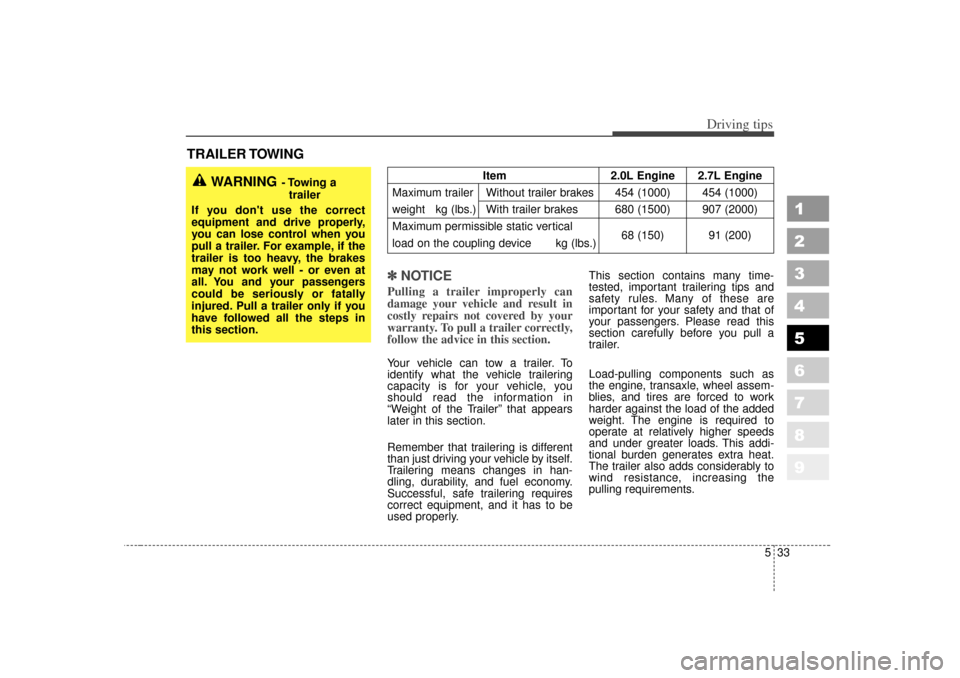
533
Driving tips
1
2
3
4
5
6
7
8
9
TRAILER TOWING✽ ✽NOTICE
Pulling a trailer improperly can
damage your vehicle and result in
costly repairs not covered by your
warranty. To pull a trailer correctly,
follow the advice in this section. Your vehicle can tow a trailer. To
identify what the vehicle trailering
capacity is for your vehicle, you
should read the information in
“Weight of the Trailer” that appears
later in this section.
Remember that trailering is different
than just driving your vehicle by itself.
Trailering means changes in han-
dling, durability, and fuel economy.
Successful, safe trailering requires
correct equipment, and it has to be
used properly. This section contains many time-
tested, important trailering tips and
safety rules. Many of these are
important for your safety and that of
your passengers. Please read this
section carefully before you pull a
trailer.
Load-pulling components such as
the engine, transaxle, wheel assem-
blies, and tires are forced to work
harder against the load of the added
weight. The engine is required to
operate at relatively higher speeds
and under greater loads. This addi-
tional burden generates extra heat.
The trailer also adds considerably to
wind resistance, increasing the
pulling requirements.
WARNING
- Towing a
trailer
If you don't use the correct
equipment and drive properly,
you can lose control when you
pull a trailer. For example, if the
trailer is too heavy, the brakes
may not work well - or even at
all. You and your passengers
could be seriously or fatally
injured. Pull a trailer only if you
have followed all the steps in
this section.
Item 2.0L Engine 2.7L Engine
Maximum trailer Without trailer brakes 454 (1000) 454 (1000)
weight kg (lbs.) With trailer brakes 680 (1500) 907 (2000)
Maximum permissible static vertical
load on the coupling device kg (lbs.) 68 (150) 91 (200)